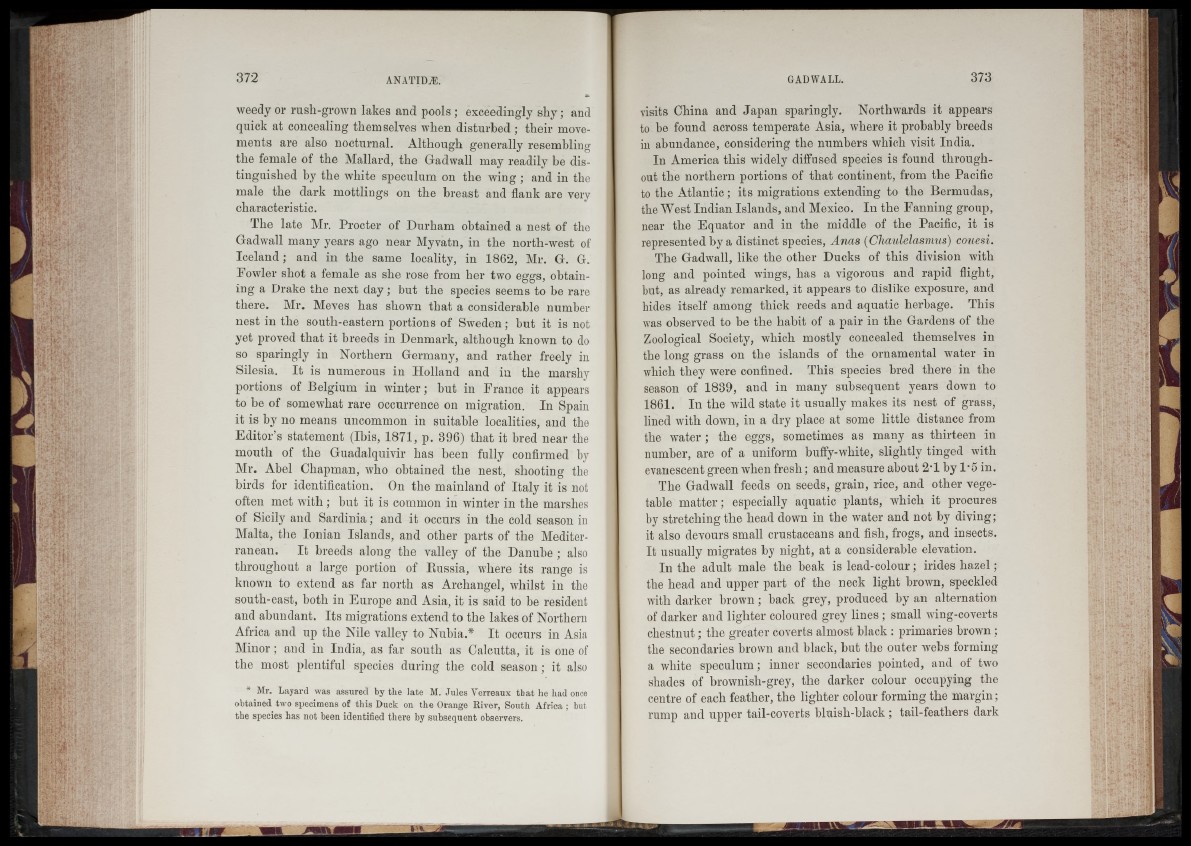
weedy or rush-grown lakes and pools ; exceedingly shy; and
quick at concealing themselves when disturbed ; their movements
are also nocturnal. Although generally resembling
the female of the Mallard, the Gadwall may readily be distinguished
by the white speculum on the wing ; and in the
male the dark mottlings on the breast and flank are very
characteristic.
The late Mr. Procter of Durham obtained a nest of the
Gadwall many years ago near Myvatn, in the north-west of
Iceland; and in the same locality, in 1862, Mr. G. G.
Fowler shot a female as she rose from her two eggs, obtaining
a Drake the next day; but the species seems to be rare
there. Mr. Meves has shown that a considerable number
nest in the south-eastern portions of Sweden; but it is not
yet proved that it breeds in Denmark, although known to do
so sparingly in Northern Germany, and rather freely in
Silesia. It is numerous in Holland and in the marshy
portions of Belgium in winter; but in France it appears
to be of somewhat rare occurrence on migration. In Spain
it is by no means uncommon in suitable localities, and the
Editor’s statement (Ibis, 1871, p. 396) that it bred near the
mouth of the Guadalquivir has been fully confirmed by
Mr. Abel Chapman, who obtained the nest, shooting the
birds for identification. On the mainland of Italy it is not
often met with; but it is common in winter in the marshes
of Sicily and Sardinia; and it occurs in the cold season in
Malta, the Ionian Islands, and other parts of the Mediterranean.
It breeds along the valley of the Danube ; also
throughout a large portion of Piussia, where its range is
known to extend as far north as Archangel, whilst in the
south-east, both in Europe and Asia, it is said to be resident
and abundant. Its migrations extend to the lakes of Northern
Africa and up the Nile valley to Nubia.* It occurs in Asia
Minor; and in India, as far south as Calcutta, it is one of
the most plentiful species during the cold season; it also
* Mr. Layard was assured by the late M. Jules Verreaux that he had once
obtained two specimens of this Duck on the Orange River, South Africa ; but
the species has not been identified there by subsequent observers.
visits China and Japan sparingly. Northwards it appears
to be found across temperate Asia, where it probably breeds
in abundance, considering the numbers which visit India.
In America this widely diffused species is found throughout
the northern portions of that continent, from the Pacific
to the Atlantic; its migrations extending to the Bermudas,
the West Indian Islands, and Mexico. In the Fanning group,
near the Equator and in the middle of the Pacific, it is
represented by a distinct species, Anas (Chaulelasmus) couesi.
The Gadwall, like the other Ducks of this division with
long and pointed wings, has a vigorous and rapid flight,
but, as already remarked, it appears to dislike exposure, and
hides itself among thick reeds and aquatic herbage. This
was observed to be the habit of a pair in the Gardens of the
Zoological Society, which mostly concealed themselves in
the long grass on the islands of the ornamental water in
which they were confined. This species bred there in the
season of 1839, and in many subsequent years down to
1861. In the wild state it usually makes its nest of grass,
lined with down, in a dry place at some little distance from
the water ; the eggs, sometimes as many as thirteen in
number, are of a uniform buffy-white, slightly tinged with
evanescent green when fresh; and measure about 2*1 by 1-5 in.
The Gadwall feeds on seeds, grain, rice, and other vegetable
matter; especially aquatic plants, which it procures
by stretching the head down in the water and not by diving;
it also devours small crustaceans and fish, frogs, and insects.
It usually migrates by night, at a considerable elevation.
In the adult male the beak is lead-colour; irides hazel;
the head and upper part of the neck light brown, speckled
with darker brown ; back grey, produced by an alternation
of darker and lighter coloured grey lines ; small wing-coverts
chestnut; the greater coverts almost black : primaries brown ;
the secondaries brown and black, but the outer webs forming
a white speculum; inner secondaries pointed, and of two
shades of brownish-grey, the darker colour occupying the
centre of each feather, the lighter colour forming the margin;
rump and upper tail-coverts bluish-black ; tail-feathers dark